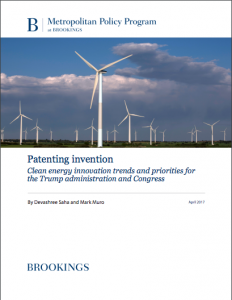Full Title: Patenting invention: Clean energy innovation trends and priorities for the Trump administration and Congress
Author(s): Devashree Saha and Mark Muro
Publisher(s): Brookings Institute
Publication Date: April 1, 2017
Full Text: Download Resource
Description (excerpt):
“Energy innovation, it’s the quickest way to make our anemic economy very powerful,” Perry declared in 2014, referring to recent breakthroughs in renewables, energy storage, and electric vehicles. And for his part Tillerson insisted in 2015: “We must recognize the role of investment and innovation in helping unlock new supplies of energy,” including from renewables.2
Tillerson especially has shown himself alert to the economic importance of innovation in keeping the United States relevant in the $1.4 trillion worldwide advanced energy sector.3
Play it right, Perry and Tillerson have seemed to suggest, and clean energy innovation holds great potential to spark job creation in U.S. regions, support the manufacturing sector, and improve the trade balance by improving American competitiveness.
And yet, there is a problem. At a moment when signs indicate the U.S. clean energy innovation enterprise could be flagging, the Trump administration has proposed draconian federal budget cuts that raise new concerns about the future of the nation’s long-term commitment to low-carbon economic development.
Under Trump’s proposed “skinny budget,” the Office of Science within the Department of Energy (DOE) would lose $900 million of its $5 billion annual appropriation, affecting DOE offices supervising early-stage research into solar, wind, nuclear, battery, and carboncapture technologies.4 Additional cuts would affect all of the department’s applied energy offices. The Trump framework also proposes eliminating the Advanced Research Projects Agency-Energy (ARPA-E), which supports early stage “moon shots” that are too risky for private investment, and axing build-out loan programs like the Advanced Technology Vehicle Manufacturing Program, which provided early support to Tesla. Making this even more untimely is the fact that several indicators of the competitiveness of U.S. cleantech innovation are raising warning lights. Eleven countries around the world now spend more on energy research and development (R&D) as a percentage of their economies than the United States does; China spends three times as much.5 Likewise, flows of the venture capital (VC) needed to help cleantech entrepreneurs build companies peaked in 2011 and have since dwindled.6 What is more, there is a perception problem: while energy innovation is a matter of broad national interest, too few Americans understand that the research, invention, testing, and commercialization that goes into it extends far beyond the usual short list of elite, green coastal tech centers in California and Massachusetts and actually reaches across the country.
So, as Congress considers the Trump budget proposals and develops its own plan, it is appropriate to assess the status of the U.S. cleantech innovation enterprise, both nationally and regionally. To that end, this BROOKINGS METROPOLITAN POLICY PROGRAM | APRIL 2017 3 brief and a forthcoming one undertake to look closely at trends and issues involving two key aspects of U.S. cleantech innovation— technology patenting and VC investment—as they are playing out across 14 clean technology areas and the nation’s diverse metropolitan areas.
Patenting matters, because patenting—a measure of new technology invention—is an intermediate step toward innovation, and patent data provide indirect and partial indicators of innovation. Patenting activity has been shown to be positively correlated with regional economic health, as high rates of patent creation are geographically associated with higher-than-average wages, lower regional unemployment, and more startup company activities.7 VC is important because it is a key form of the early-stage financing that is frequently necessary to allow innovative new energy companies to grow.8 VC has also been shown to play a key role in advancing key segments of the innovation economy of the United States over the last several decades.
